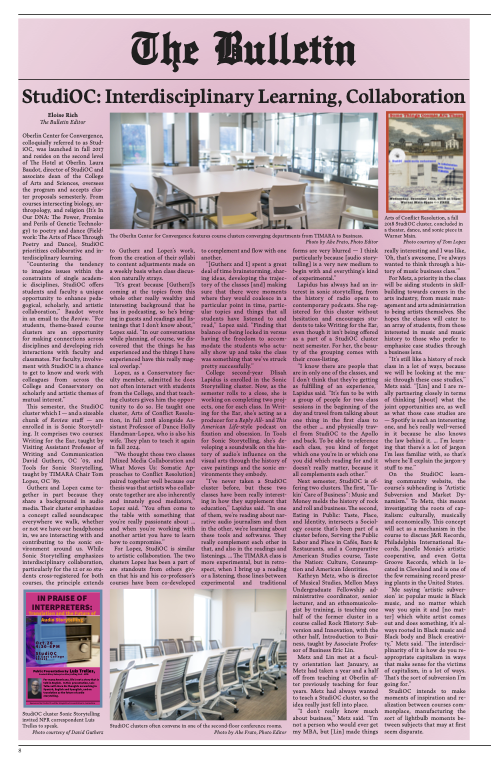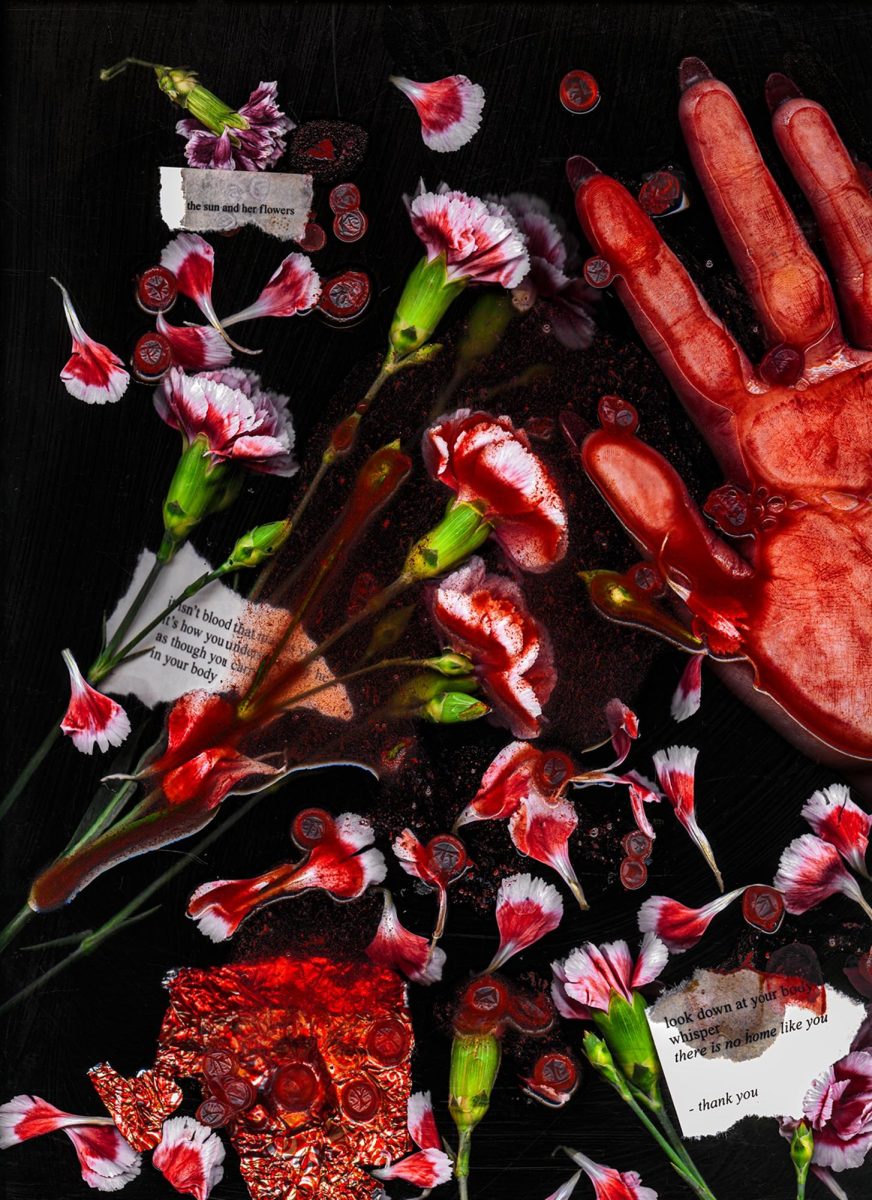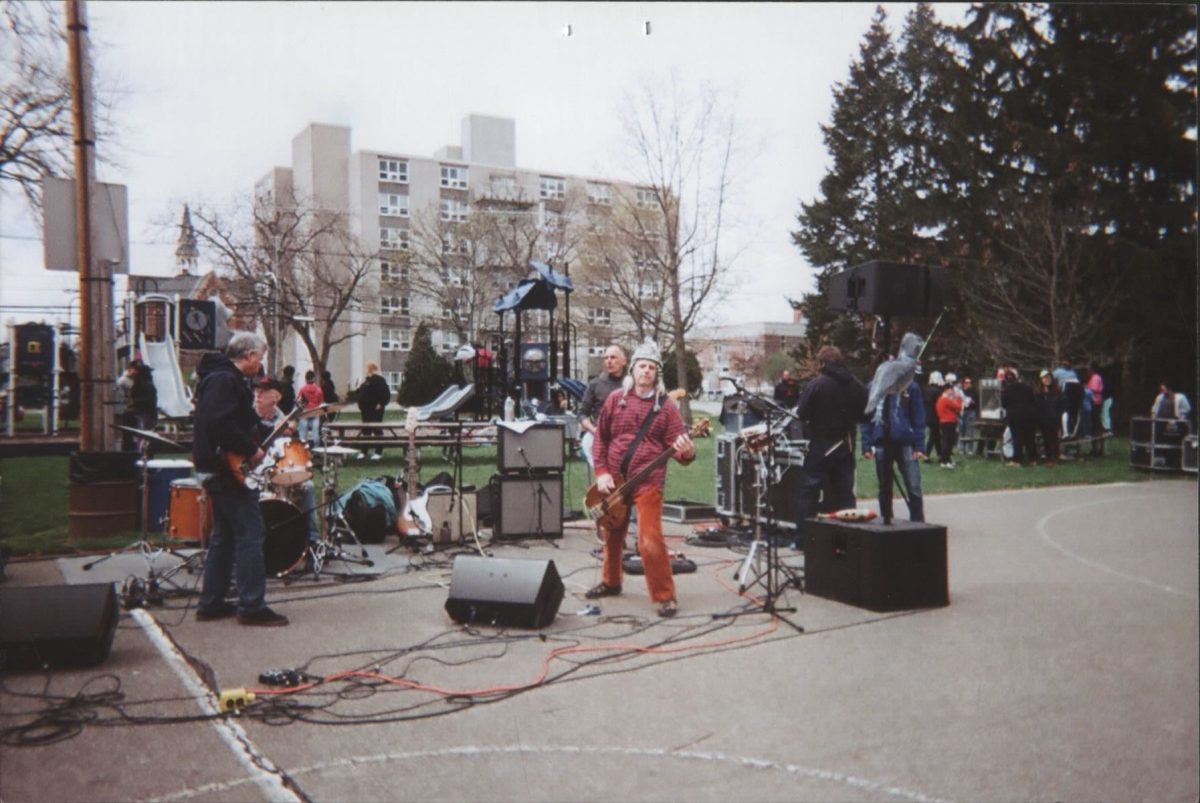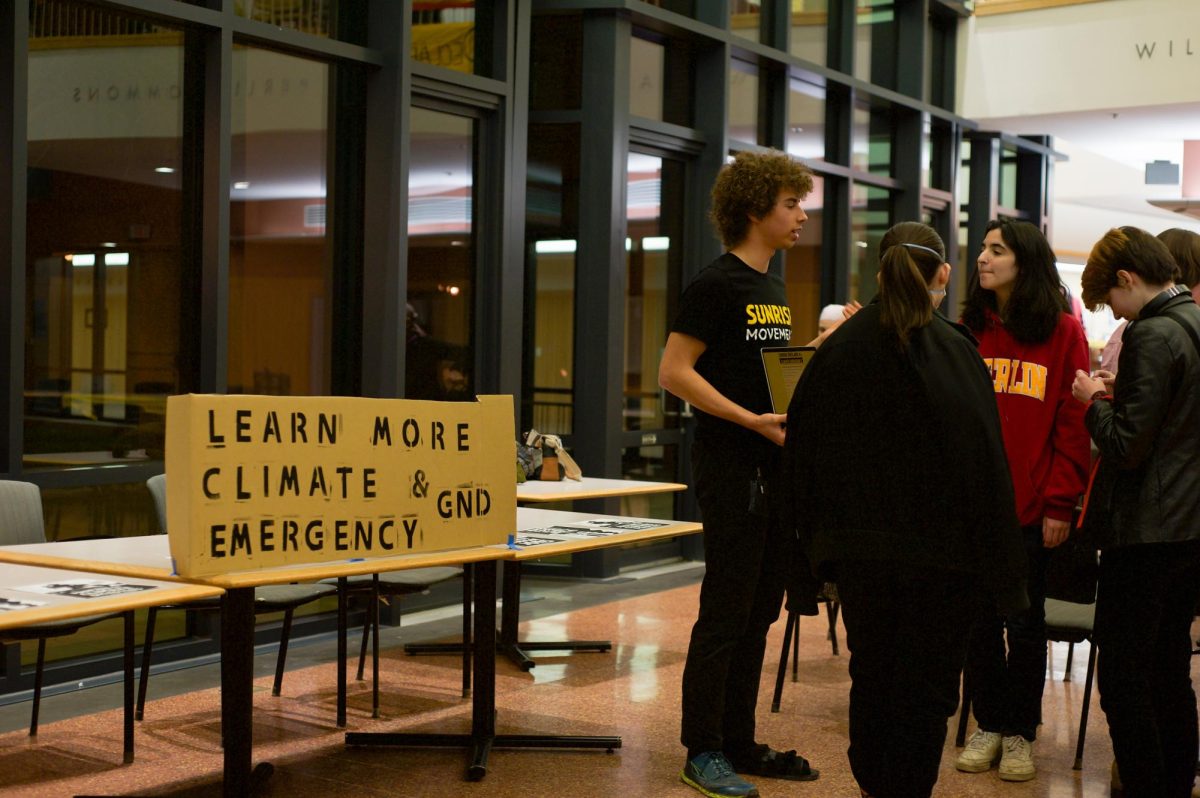Oberlin Center for Convergence, colloquially referred to as StudiOC, was launched in fall 2017 and resides on the second level of The Hotel at Oberlin. Laura Baudot, director of StudiOC and associate dean of the College of Arts and Sciences, oversees the program and accepts cluster proposals semesterly. From courses intersecting biology, anthropology, and religion (It’s In Our DNA: The Power, Promise and Perils of Genetic Technology) to poetry and dance (Fieldwork: The Arts of Place Through Poetry and Dance), StudiOC prioritizes collaborative and interdisciplinary learning.
“Countering the tendency to imagine issues within the constraints of single academic disciplines, StudiOC offers students and faculty a unique opportunity to enhance pedagogical, scholarly, and artistic collaboration,” Baudot wrote in an email to the Review. “For students, theme-based course clusters are an opportunity for making connections across disciplines and developing rich interactions with faculty and classmates. For faculty, involvement with StudiOC is a chance to get to know and work with colleagues from across the College and Conservatory on scholarly and artistic themes of mutual interest.”
This semester, the StudiOC cluster which I — and a sizeable chunk of Review staff — are enrolled in is Sonic Storytelling. It comprises two courses: Writing for the Ear, taught by Visiting Assistant Professor of Writing and Communication David Gutherz, OC ’09, and Tools for Sonic Storytelling, taught by TIMARA Chair Tom Lopez, OC ’89.
Gutherz and Lopez came together in part because they share a background in audio media. Their cluster emphasizes a concept called soundscapes: everywhere we walk, whether or not we have our headphones in, we are interacting with and contributing to the sonic environment around us. While Sonic Storytelling emphasizes interdisciplinary collaboration, particularly for the 12 or so students cross-registered for both courses, the principle extends to Gutherz and Lopez’s work, from the creation of their syllabi to content adjustments made on a weekly basis when class discussion naturally strays.
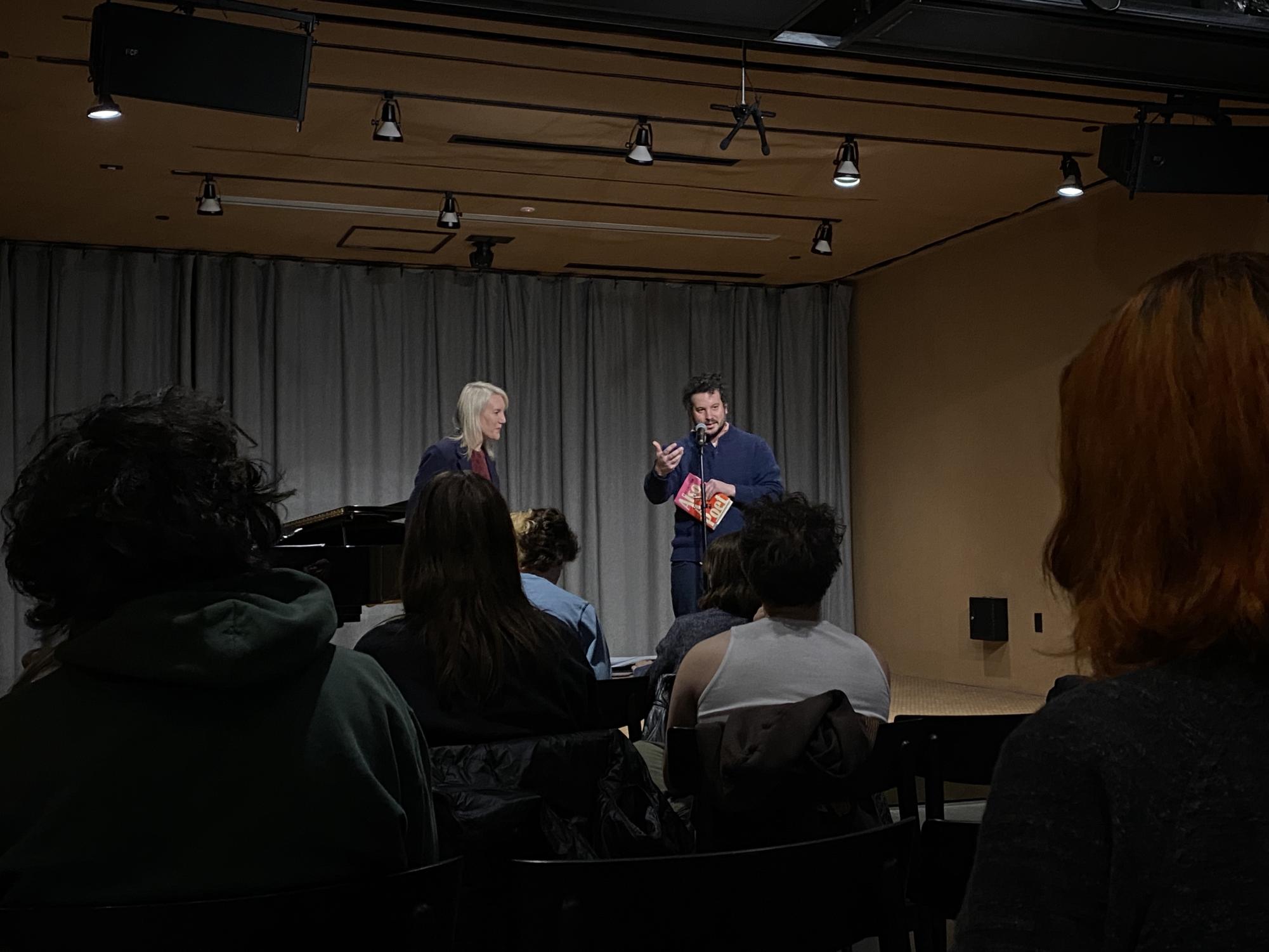
“It’s great because [Gutherz]’s coming at the topics from this whole other really wealthy and interesting background that he has in podcasting, so he’s bringing in guests and readings and listenings that I don’t know about,” Lopez said. “In our conversations while planning, of course, we discovered that the things he has experienced and the things I have experienced have this really magical overlap.”
Lopez, as a Conservatory faculty member, admitted he does not often interact with students from the College, and that teaching clusters gives him the opportunity to do so. He taught one cluster, Arts of Conflict Resolution, in fall 2018 alongside Assistant Professor of Dance Holly Handman-Lopez, who is also his wife. They plan to teach it again in fall 2024.
“We thought those two classes [Mixed Media Collaboration and What Moves Us: Somatic Approaches to Conflict Resolution] paired together well because our thesis was that artists who collaborate together are also inherently and innately good mediators,” Lopez said. “You often come to the table with something that you’re really passionate about … and when you’re working with another artist you have to learn how to compromise.”
For Lopez, StudiOC is similar to artistic collaboration. The two clusters Lopez has been a part of are standouts from others given that his and his co-professor’s courses have been co-developed to complement and flow with one another.
“[Gutherz and I] spent a great deal of time brainstorming, sharing ideas, developing the trajectory of the classes [and] making sure that there were moments where they would coalesce in a particular point in time, particular topics and things that all students have listened to and read,” Lopez said. “Finding that balance of being locked in versus having the freedom to accommodate the students who actually show up and take the class was something that we’ve struck pretty successfully.”
College second-year Dlisah Lapidus is enrolled in the Sonic Storytelling cluster. Now, as the semester rolls to a close, she is working on completing two projects, one for each class. In Writing for the Ear, she’s acting as a producer for a Reply All- and This American Life-style podcast on fixation and obsession. In Tools for Sonic Storytelling, she’s developing a soundwalk on the history of audio’s influence on the visual arts through the history of cave paintings and the sonic environments they embody.
“I’ve never taken a StudiOC cluster before, but these two classes have been really interesting in how they supplement that education,” Lapidus said. “In one of them, we’re reading about narrative audio journalism and then in the other, we’re learning about these tools and softwares. They really complement each other in that, and also in the readings and listenings. … The TIMARA class is more experimental, but in retrospect, when I bring up a reading or a listening, those lines between experimental and traditional forms are very blurred — I think particularly because audio media is a very new medium to begin with and everything’s kind of experimental.”
Lapidus has always had an interest in sonic storytelling, from the history of radio opera to contemporary podcasts. She registered for this cluster without hesitation and encourages students to take Writing for the Ear, even though it isn’t being offered as a part of a StudiOC cluster next semester. For her, the beauty of the grouping comes with their cross-listing.
“I know there are people that are in only one of the classes, and I don’t think that they’re getting as fulfilling of an experience,” Lapidus said. “It’s fun to be with a group of people for two class sessions in the beginning of the day and travel from talking about one thing in the first class to the other … and physically travel from StudiOC to the Apollo and back. To be able to reference each class, you kind of forget which one you’re in or which one you did which reading for and it doesn’t really matter, because it all complements each other.”
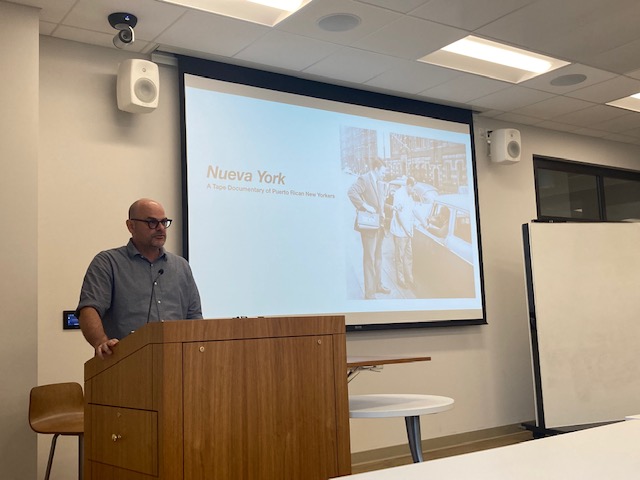
Next semester, StudiOC is offering two clusters. The first, “Takin’ Care of Business”: Music and Money melds the history of rock and roll and business. The second, Eating in Public: Taste, Place, and Identity, intersects a Sociology course that’s been part of a cluster before, Serving the Public Labor and Place in Cafés, Bars & Restaurants, and a Comparative American Studies course, Taste the Nation: Culture, Consumption and American Identities.
Kathryn Metz, who is director of Musical Studies, Mellon Mays Undergraduate Fellowship administrative coordinator, senior lecturer, and an ethnomusicologist by training, is teaching one half of the former cluster in a course called Rock History: Subversion and Innovation, with the other half, Introduction to Business, taught by Associate Professor of Business Eric Lin.
Metz and Lin met at a faculty orientation last January, as Metz had taken a year and a half off from teaching at Oberlin after previously teaching for four years. Metz had always wanted to teach a StudiOC cluster, so the idea really just fell into place.
“I don’t really know much about business,” Metz said. “I’m not a person who would ever get my MBA, but [Lin] made things really interesting and I was like, ‘Oh, that’s awesome, I’ve always wanted to think through a history of music business class.’”
For Metz, a priority in the class will be aiding students in skillbuilding towards careers in the arts industry, from music management and arts administration to being artists themselves. She hopes the classes will cater to an array of students, from those interested in music and music history to those who prefer to emphasize case studies through a business lens.
“It’s still like a history of rock class in a lot of ways, because we will be looking at the music through these case studies,” Metz said. “[Lin] and I are really partnering closely in terms of thinking [about] what the joint opportunities are, as well as what those case studies are — Spotify is such an interesting one, and he’s really well-versed in it because he also knows the law behind it. … I’m learning that there’s a lot of jargon I’m less familiar with, so that’s where he’ll explain the jargon-y stuff to me.”
On the StudiOC learning community website, the course’s subheading is “Artistic Subversion and Market Dynamism.” To Metz, this means investigating the roots of capitalism: culturally, musically and economically. This concept will act as a mechanism in the course to discuss J&R Records, Philadelphia International Records, Janelle Monáe’s artistic cooperative, and even Gotta Groove Records, which is located in Cleveland and is one of the few remaining record pressing plants in the United States.
“Me saying ‘artistic subversion’ is: popular music is Black music, and no matter which way you spin it and [no matter] which white artist comes out and does something, it’s always rooted in Black music and Black body and Black creativity,” Metz said. “The interdisciplinarity of it is how do you reappropriate capitalism in ways that make sense for the victims of capitalism, in a lot of ways. That’s the sort of subversion I’m going for.”
StudiOC intends to make moments of inspiration and realization between courses commonplace, manufacturing the sort of lightbulb moments between subjects that may at first seem disparate.
